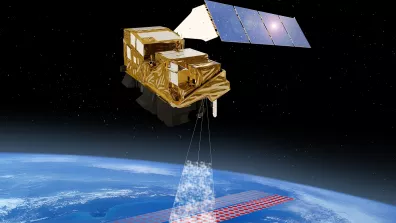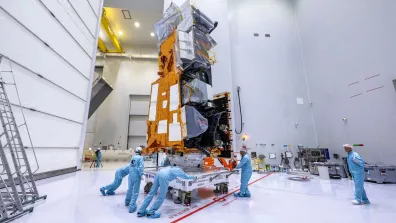The IASI instrument (Infrared Atmospheric Sounding Interferometer) has been flying on Europe’s MetOp weather satellites since 2006. As well as acquiring temperature and humidity data, IASI also measures more than 25 other atmospheric components with a high degree of precision. IASI data are vitally important for weather forecasting, pollution monitoring and climate research. To ensure continuity, CNES is working on its successor, the IASI-NG next-generation instrument.
Key information
| Mission | Analyse Earth’s atmosphere (temperature, humidity, composition, climate variables) |
|---|---|
| Domain | Earth observation |
| Launch date | August 12, 2025 |
| Partners | Eumetsat |
| Where | MetOp-SG-A1, MetOp-SG-A2, MetOp-SG-A3 satellites |
| Lifetime | 20 years |
| Status | In operation |
Key figures
- 1,296,000 atmospheric spectra measured per day
- 0.25 cm-1 spectral resolution
- 0.25 K radiometric performance
- 20 years of observations
- 12 km spatial resolution
- 25 atmospheric components measured
Key milestones
- 2039: Launch of MetOp-SG A3
- 2032: Launch of MetOp-SG A2
- 2026: Delivery of third IASI-NG flight model
- 2025: Delivery of second IASI-NG flight model
- August 2025: Launch of MetOp-SG A1
- 2024: Delivery of IASI-NG data processing chain
- 2022: Delivery of first IASI-NG flight model
- March-April 2020: Detailed Design Review of IASI-NG system
- End 2019: Detailed Design Review of IASI-NG instrument
- Mid-2015: Preliminary Definition Review of IASI-NG system
- 2015: Preliminary Definition Review of IASI-NG instrument
- 2013: CNES selects IASI-NG instrument prime contractor
- 2013: CNEs gives go-ahead for IASI-NG programme
Project in brief
Like its predecessor, the IASI New Generation instrument (IASI-NG) is an infrared atmospheric sounding sensor designed to determine temperature and water vapour profiles in the atmosphere, record ocean surface and land temperatures and monitor a vast range of chemical compounds and other key variables for climate research, including greenhouse gases, desert dust and cloud cover. With its innovative optical configuration, IASI-NG’s spectral resolution and signal-to-noise ratio will be improved by a factor of two. Measurement precision will also be improved (1 K for temperature and 10% for humidity).
More than just a continuation of IASI, IASI-NG is a real asset for atmosphere sciences, particularly numerical weather prediction models, atmospheric composition studies and climate research, thanks to its far-reaching engineering and technological innovations. It is a key element of Europe’s three future MetOp-SG-A series weather satellites, scheduled to launch in 2025, 2032 and 2039.
CNES’s role
IASI-NG is scheduled to fly with other instruments on the MetOp-SG satellite developed by the European Space Agency (ESA) and operated by Eumetsat. Within this partnership, CNES has overall technical responsibility for the three flight models of the IASI-NG instruments up to in-orbit commissioning. It is also tasked with developing the chain for processing raw data from the instrument into Level 1 products. Further, CNES is in charge of developing and operating a technical expertise centre to monitor the instrument’s performance in orbit.
Contacts
IASI-NG Project Leader
François Bermudo
E-mail: francois.bermudo at cnes.fr
IASI-NG Instrument Manager
Antoine Penquer
E-mail: antoine.penquer at cnes.fr
IASI-NG System Manager
Clémence Le Fèvre
E-mail: clemence.lefevre at cnes.fr
Atmospheric Physics & Meteorology subject matter expert
Adrien Deschamps
E-mail: adrien.deschamps at cnes.fr
Atmospheric Composition & Carbon Cycle subject matter expert
Carole Deniel
E-mail: carole.deniel at cnes.fr




